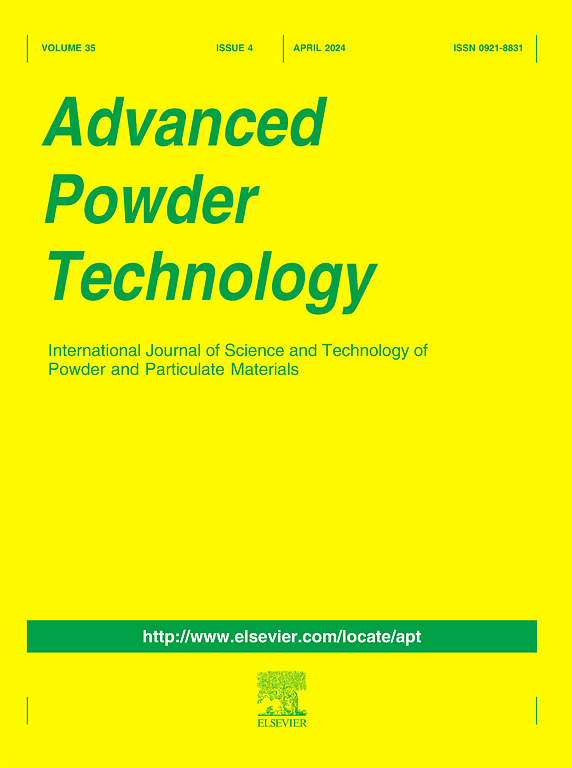Modelling the electrical conductivity of Lithium-ion battery electrodes via a bonded-particle approach
IF 4.2
2区 工程技术
Q2 ENGINEERING, CHEMICAL
引用次数: 0
Abstract
An electrode’s electrical conductivity greatly affects battery performance, justifying the need to fully understand the relation between particle microstructure and resulting electrical conductivity. This work proposes a model to assess the specific electrical conductivity of DEM electrode structures by analysing a network of conductive paths.
NMC622- and NCA-based cathode structures, with a bond network representing the additive-binder matrix, are created and calendered numerically before being evaluated for electronic conductivity. The direct and bond contacts and, unprecedentedly, the internal particle resistances are taken into account to build a resistor network. The results obtained by this model are in great agreement with experimental electrical conductivities for NMC622- and NCA-based cathodes. Both the experimental cathodes and the developed conductivity model show an initial increase and later decrease of electrical conductivity as a function of calendering load, which is explained by a loss in particle bonds. Variations in the active material size distribution lead to the same changes in the electronic conductivity of experimental and simulated cathodes. This is attributed to the coordination number of the active material particles and the different types of particle contacts.
To conclude, this model allows for a DEM simulation-independent, accurate evaluation of the electrical conductivity of any discrete particulate structure.

用键合粒子方法模拟锂离子电池电极的电导率
电极的导电性极大地影响电池的性能,因此有必要充分了解颗粒微观结构与导电性之间的关系。这项工作提出了一个模型,通过分析导电路径网络来评估DEM电极结构的特定电导率。基于NMC622和nca的阴极结构,具有代表添加剂-粘合剂矩阵的键网络,在评估电子导电性之前进行了数值计算和压延。直接接触和键接触以及前所未有的内部粒子电阻被考虑在内,以构建一个电阻网络。该模型得到的结果与NMC622和nca基阴极的实验电导率非常吻合。实验阴极和所建立的电导率模型都显示出电导率随压延负荷的变化先增大后减小,这可以用粒子键的损失来解释。活性材料尺寸分布的变化导致实验和模拟阴极的电子导电性发生相同的变化。这是由于活性物质颗粒的配位数和颗粒接触类型的不同。综上所述,该模型可以独立于DEM模拟,准确评估任何离散颗粒结构的电导率。
本文章由计算机程序翻译,如有差异,请以英文原文为准。
求助全文
约1分钟内获得全文
求助全文
来源期刊

Advanced Powder Technology
工程技术-工程:化工
CiteScore
9.50
自引率
7.70%
发文量
424
审稿时长
55 days
期刊介绍:
The aim of Advanced Powder Technology is to meet the demand for an international journal that integrates all aspects of science and technology research on powder and particulate materials. The journal fulfills this purpose by publishing original research papers, rapid communications, reviews, and translated articles by prominent researchers worldwide.
The editorial work of Advanced Powder Technology, which was founded as the International Journal of the Society of Powder Technology, Japan, is now shared by distinguished board members, who operate in a unique framework designed to respond to the increasing global demand for articles on not only powder and particles, but also on various materials produced from them.
Advanced Powder Technology covers various areas, but a discussion of powder and particles is required in articles. Topics include: Production of powder and particulate materials in gases and liquids(nanoparticles, fine ceramics, pharmaceuticals, novel functional materials, etc.); Aerosol and colloidal processing; Powder and particle characterization; Dynamics and phenomena; Calculation and simulation (CFD, DEM, Monte Carlo method, population balance, etc.); Measurement and control of powder processes; Particle modification; Comminution; Powder handling and operations (storage, transport, granulation, separation, fluidization, etc.)
 求助内容:
求助内容: 应助结果提醒方式:
应助结果提醒方式:


